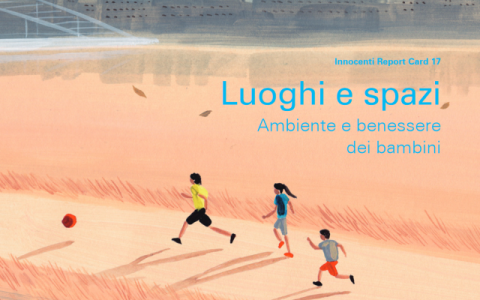
Most rich countries are creating unhealthy, dangerous and harmful conditions for children around the world. The recent Innocenti Report Card 17Locations and Spaces. Environment and Children's Well-Being, conducted by the Unicef Innocenti Research Centre, compares the results achieved by 39 countries of the Organisation for Economic Cooperation and Development (OECD) and the European Union (EU) in providing healthy environments for the new generations, outlining a picture that shows that there is still a long way to go to reduce the damage and inequalities that fall on the youngest children.>
The ranking of environmental conditions related to child well-being assesses three key spheres of influence in the 39 countries considered: the world of the child (direct and tangible effects of the interaction of children with different environments, for example through the consumption of air and water and exposure to harmful substances); the world around the child (natural and artificial environments with which the under-18 interact directly, such as green spaces and road traffic); the world as a whole (broader aspects of the physical and political environment surrounding children's microsystems at regional, national and global levels, such as greenhouse gas emissions and e-waste management).
"The report", reads the Unicef website, "states that if all the world's citizens consumed resources at the rate of the OECD and EU countries, the equivalent of 3.3 planet Earths would be needed to maintain consumption levels. If everyone consumed resources at the rate of Canada, Luxembourg and the United States, at least five planet Earths would be needed."
According to the Report Card, although Spain, Ireland and Portugal occupy the top spots in the overall ranking, all OECD and EU countries fail to provide healthy environments for all children in all indicators. Some of the richest countries, including Australia, Belgium, Canada and the United States, have a serious and widespread impact on the global environment - based on CO2 emissions, e-waste and overall resource consumption per capita - and also rank last in creating a healthy environment for children within their borders. In contrast, the less wealthy OECD and EU countries in Latin America and Europe have a much lower impact worldwide.
Other data reveal that more than 20 million children have high levels of lead in their blood and in Belgium, the Czech Republic, Israel, the Netherlands, Poland and Switzerland more than one child in every 12 is exposed to high levels of pesticide pollution.
"Finland, Iceland and Norway rank in the top third in providing a healthy environment for their children but end up in the last third of the ranking for "The world as a whole," with high rates of emissions, electronic waste and consumption"; in Iceland, Latvia, Portugal and the UK one in 5 children is exposed to damp or mould at home (in Cyprus, Hungary and Turkey more than one in 4).
In the report's ranking, our country ranks 6th out of 39. In particular, Italy is in a good position (7th place) for "air and water pollution and lead poisoning" and in average positions (16th and 14th place) for "overcrowding, urban green spaces and road safety" and "number of planet Earths consumed, e-waste production and consumption-based CO2 emissions." The most critical issues are related to the housing situation and involve: the percentage of households with children who have difficulty heating their homes (10%); households living in an overcrowded home (18.9%); the percentage of children under the age of 6 living in severe housing deprivation (5.9%); overcrowding conditions in the 20% of households with the lowest income (24.3%).
The publication is available on the Unicef website, in the dedicated news item.
Other materials and news can be found on this site on the Environment and Well-being topics, which can be accessed from the "Topics" navigation menu.

